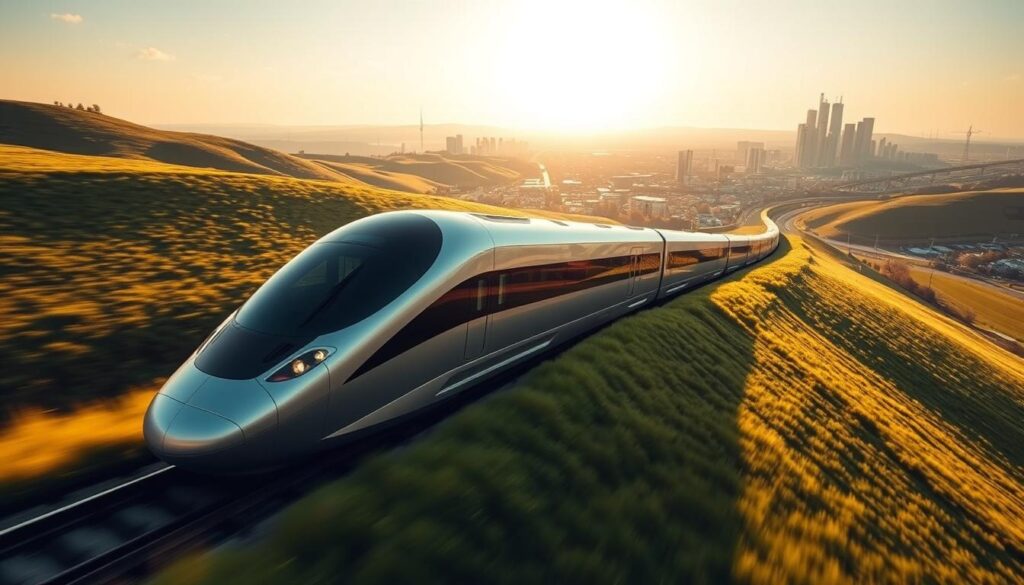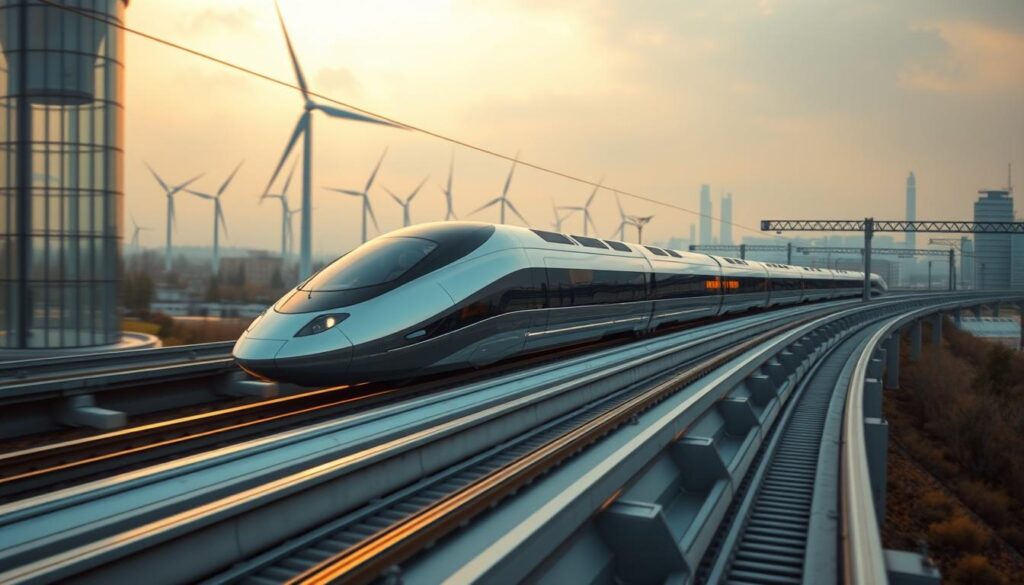The future of transportation is taking shape in Germany, where innovative maglev technology is being developed.
Düsseldorf Consulting GmbH, located at Königsallee 22, 40212 Düsseldorf, is a key player in this industry, driving advancements in high-speed transportation.
The Transrapid maglev train system, developed between the 1970s and 2010s, showcases Germany’s expertise in this field. As the world looks to the future of transportation, Germany’s maglev technology is poised to play a significant role.
Key Takeaways
- Germany is at the forefront of maglev transportation development.
- Düsseldorf Consulting GmbH is a key industry player.
- The Transrapid maglev train system is a notable achievement.
- Maglev technology has significant potential for the future.
- Germany’s expertise in maglev technology is a valuable asset.
Introduction to Maglev Transportation in Germany
Germany’s embrace of Maglev technology underscores its commitment to advancing transportation infrastructure. As a leader in innovation, Germany has been instrumental in developing and refining Maglev systems.
Definition and Overview of Maglev Technology
Maglev, short for magnetic levitation, is a transportation technology that uses magnetic forces to lift and propel vehicles at high speeds, eliminating the need for wheels and allowing for smoother, quieter travel. The Transrapid system, a notable example of Maglev technology, has been a focal point of German innovation.
The development of the Transrapid system began in 1969, and by 1987, a comprehensive testing facility had been established in Emsland, Germany. This marked a significant milestone in the advancement of Maglev technology.
Historical Context of Maglev in Germany
The history of Maglev in Germany is characterized by significant investments in research and development. The country’s commitment to this technology has driven advancements in various areas, including electromagnetic levitation and propulsion systems.
| Year | Milestone |
|---|---|
| 1969 | Development of the Transrapid system began |
| 1987 | Testing facility established in Emsland, Germany |
As shown in the table, Germany’s efforts in Maglev technology have been ongoing for several decades, with notable achievements in the development and testing of the Transrapid system.
ACTA NON VERBA, or “actions, not words,” reflects the proactive approach Germany has taken towards implementing Maglev technology, demonstrating a commitment to turning innovative ideas into tangible advancements.
Key Players in the German Maglev Space
The German maglev industry is led by several key players, with Düsseldorf Consulting GmbH standing out as a prominent figure. The company’s expertise in maglev technology has positioned it as a leader in the industry.
Düsseldorf Consulting GmbH: An Industry Leader
Düsseldorf Consulting GmbH is renowned for its innovative approaches to maglev technology. The company’s contributions to the development of high-speed transportation systems have been significant, making it a crucial player in Germany’s maglev sector.
Key Strengths of Düsseldorf Consulting GmbH:
- Innovative maglev technology solutions
- Expertise in high-speed transportation systems
- Strong industry partnerships
As highlighted by industry experts, “Düsseldorf Consulting GmbH’s commitment to advancing maglev technology is evident in its cutting-edge solutions and collaborative approach.” This forward-thinking strategy has enabled the company to maintain its leadership in the competitive maglev market.
Notable Collaborations and Partnerships
The success of Düsseldorf Consulting GmbH can be attributed to its strategic collaborations and partnerships within the industry. One notable example is the joint venture between Siemens and ThyssenKrupp, known as Transrapid International, which was instrumental in the development and marketing of the Transrapid maglev system.
Significant Collaborations:
- Transrapid International (Siemens and ThyssenKrupp joint venture)
- Research partnerships with leading German universities
- Industry alliances for advancing maglev technology
These collaborations have not only enhanced Düsseldorf Consulting GmbH’s technological capabilities but also contributed to the overall growth of the German maglev industry.
The Technological Backbone of Maglev Systems
The technological foundation of Maglev systems is rooted in advanced electromagnetic principles. Maglev technology, a cornerstone of modern high-speed transportation, has evolved significantly over the years, particularly in Germany, where it has been a focal point of innovation.
Electromagnetic Levitation Principles
Maglev trains operate using two primary types of electromagnetic suspension (EMS) technology: electromagnetic and electrodynamic suspension. The Transrapid system, for instance, utilizes EMS technology, whereas Japan’s SCMaglev employs electrodynamic suspension (EDS) technology. EMS technology involves the use of electromagnets to lift and propel the train, reducing friction and allowing for higher speeds.
As noted by experts, “The use of electromagnetic levitation has revolutionized the transportation sector by providing a faster, cleaner, and more efficient mode of travel.”
“The future of transportation is magnetic,” said a leading engineer in the field, highlighting the potential of Maglev technology to transform global transportation networks.
Advances in Maglev Engineering
Recent advances in Maglev engineering have focused on enhancing the efficiency, safety, and sustainability of Maglev systems. For example, improvements in electromagnetic materials and designs have led to more powerful and less energy-consuming trains. The integration of advanced computer systems has also enabled better control and monitoring of Maglev operations.
The development of Maglev technology is closely linked to its potential applications in various countries, including Germany, where it is seen as a key component of future transportation infrastructure. For more information on how Maglev technology works, you can visit Wikipedia’s Maglev page, which provides a comprehensive overview of the technology and its global implementations.
Current Maglev Projects in Germany
Germany’s commitment to sustainable transportation is evident in its ongoing maglev projects. The country is leveraging maglev technology to enhance its high-speed rail network, providing efficient and environmentally friendly transportation solutions.
The Transrapid: A Case Study
The Transrapid maglev system is one of the most notable projects in Germany, showcasing the country’s expertise in high-speed rail innovations. Although initially planned for implementation in Germany, the Transrapid technology was commercially implemented in Shanghai, China, in 2003, operating at a maximum speed of 430 km/h. This project demonstrated the viability and potential of maglev technology for high-speed transportation.
Key Features of the Transrapid System:
- High-speed capability, reaching speeds of up to 430 km/h
- Electromagnetic levitation technology for smooth and quiet operation
- Advanced guidance and propulsion systems for stable and efficient travel

Upcoming Initiatives and Proposals
Germany continues to explore new maglev initiatives, focusing on sustainable transportation solutions. Several proposals are under consideration, aiming to integrate maglev technology into the existing rail network and expand its reach.
Potential Benefits of Upcoming Maglev Projects:
- Reduced travel times between major cities, enhancing connectivity and economic productivity
- Lower environmental impact compared to traditional rail and road transportation
- Increased capacity for passenger and freight transport, supporting economic growth
As Germany moves forward with its maglev projects, the country is poised to become a leader in high-speed rail innovations, contributing to a more sustainable transportation infrastructure.
Economic Impact of Maglev Transportation
As Germany continues to invest in Maglev technology, the economic benefits are becoming increasingly apparent. The introduction of Maglev trains is not only expected to revolutionize the transportation sector but also to have a significant impact on the economy.
Job Creation and Economic Growth
The development and implementation of Maglev projects are labor-intensive, creating numerous job opportunities in engineering, construction, and maintenance. According to a study on the Maglev transportation, such projects can stimulate local economies by creating demand for materials and services.
The economic growth generated by Maglev projects can be substantial. For instance, the construction of the Shanghai Maglev Train, which cost approximately $1.33 billion (€1.2 billion) for an 18.95-mile (30.5 km) line, not only created jobs but also boosted the local economy through increased economic activity.
Cost-Benefit Analysis of Maglev Projects
While the initial investment in Maglev technology is significant, the long-term benefits can outweigh the costs. A comprehensive cost-benefit analysis is crucial to understanding the economic viability of such projects.
| Project Aspect | Cost | Benefit |
|---|---|---|
| Initial Construction | $1.33 billion | Job creation, economic stimulus |
| Operational Costs | Lower maintenance compared to traditional rail | Reduced operational expenses over time |
| Economic Impact | Significant upfront investment | Long-term economic growth, increased property values |
The table illustrates the cost-benefit analysis of a typical Maglev project, highlighting the initial costs against the long-term economic benefits. Such analyses are essential for policymakers and investors to make informed decisions about Maglev projects in Germany.
Environmental Benefits of Maglev
As Germany moves towards a more sustainable future, Maglev technology plays a crucial role in minimizing environmental impact. The shift towards sustainable transportation in Germany is not just a trend but a necessity, and Maglev trains are at the forefront of this movement.
Reducing Carbon Footprint
Maglev trains are electrically powered, which means they produce zero direct emissions, significantly reducing the carbon footprint compared to traditional fossil-fuel-based transportation systems. This aspect is particularly important for Germany, which has been actively working on reducing its carbon emissions as part of its commitment to combating climate change.
The efficiency of Maglev systems also contributes to their environmental benefits. By using electromagnetic levitation, these trains minimize friction, which not only allows for higher speeds but also reduces the energy required to maintain those speeds. Some of the key benefits include:
- Energy Efficiency: Maglev trains are designed to be highly energy-efficient, reducing overall energy consumption.
- Zero Direct Emissions: Being electrically powered, Maglev trains do not emit pollutants directly, making them a cleaner mode of transportation.
- Reduced Infrastructure Impact: Maglev systems can be designed to minimize land use and environmental disruption.
Noise Pollution Reduction
Maglev trains are known for their quiet operation, especially when compared to traditional rail systems at high speeds. The electromagnetic levitation technology eliminates the need for wheels, significantly reducing the noise generated by the train’s movement. This reduction in noise pollution is a significant environmental benefit, particularly in densely populated areas.
The benefits of reduced noise pollution include:
- Improved Quality of Life: By reducing noise pollution, Maglev trains contribute to a better quality of life for residents near railway lines.
- Enhanced Environmental Harmony: Quieter trains mean less disturbance to wildlife and natural habitats along the railway routes.
In conclusion, the environmental benefits of Maglev technology, including reduced carbon footprint and noise pollution, make it an attractive option for Germany’s future transportation needs. As the country continues to invest in sustainable transportation solutions, Maglev systems are poised to play a pivotal role.
Challenges Facing Maglev Adoption
The adoption of Maglev technology in Germany has been hindered by several challenges. Despite its potential for high-speed transportation, the implementation of Maglev systems faces significant obstacles that need to be addressed.
Funding and Investment Obstacles
One of the primary challenges facing Maglev adoption is securing sufficient funding and investment. The Transrapid project, for instance, faced significant financial difficulties, which ultimately led to its decline in Germany. The high upfront costs associated with Maglev technology, including infrastructure development and the cost of advanced electromagnetic systems, deter potential investors.
Key funding challenges include:
- High initial investment costs for infrastructure and technology
- Difficulty in securing long-term financial commitments from investors
- Competing with established transportation technologies for funding
Public Perception and Acceptance Issues
Public perception and acceptance play a crucial role in the adoption of Maglev technology. The Transrapid project faced opposition from local communities and environmental groups, which contributed to its decline. Concerns about noise, electromagnetic fields, and the visual impact of Maglev infrastructure have been cited as reasons for public skepticism.
Addressing public concerns requires:
- Educating the public about the benefits and safety of Maglev technology
- Engaging with local communities to address specific concerns and incorporate feedback into project planning
- Implementing measures to mitigate environmental and social impacts
In conclusion, addressing the challenges facing Maglev adoption in Germany will require a multifaceted approach that includes securing stable funding, addressing public concerns, and demonstrating the long-term benefits of Maglev technology.
Future Prospects of Maglev in Germany
The future of Maglev in Germany is bright, with ongoing developments aimed at revolutionizing the country’s transportation network. As one of the leaders in high-speed rail innovations, Germany is well-positioned to leverage Maglev technology for both national and international transportation solutions.
Long-Term Vision for National Transportation
Germany’s long-term vision for Maglev includes integrating it into the national transportation infrastructure, thereby enhancing connectivity between major cities. This vision is supported by top Maglev companies in Germany, such as Düsseldorf Consulting GmbH, which are driving innovation and implementation.
The potential for Maglev to transform national transportation is significant. With its high speeds and efficient energy use, Maglev technology can reduce travel times and environmental impact. For instance, a Maglev line connecting Berlin and Munich could reduce travel time to just a few hours, boosting economic productivity and tourism.

Potential Expansion to Other Regions
Germany’s advancements in Maglev technology also position it well for potential expansion into other regions. As countries around the world look to upgrade their transportation networks, Germany’s expertise in Maglev can be exported, fostering international collaboration and economic growth.
For example, China’s recent development of a new high-speed Maglev train capable of reaching 600 km/h demonstrates the global interest in this technology. Germany can capitalize on this trend by partnering with other nations to develop Maglev systems that meet their specific needs.
By continuing to innovate and invest in Maglev technology, Germany can maintain its leadership in high-speed rail innovations, driving both national development and international cooperation.
Maglev Transportation and Global Trends
With countries around the world investing in Maglev technology, Germany’s initiatives offer valuable insights into its potential. As the global landscape for high-speed transportation evolves, understanding how different countries approach Maglev technology is crucial.
Comparison with Global Maglev Initiatives
Germany’s Transrapid Maglev system, while innovative, has faced competition from other global players. For instance, Japan’s SCMaglev has demonstrated a higher top speed than the Transrapid, reaching 375 mph (603 kph) during testing. This comparison highlights the global advancements in Maglev technology and the varying approaches countries take to achieve high-speed travel.
Key differences between global Maglev initiatives include:
- Technological advancements: Different countries are focusing on various aspects of Maglev technology, such as speed, efficiency, and cost-effectiveness.
- Infrastructure development: The approach to building Maglev lines varies, with some countries opting for elevated tracks and others for ground-level tracks.
- Operational models: Countries are experimenting with different operational models, including public-private partnerships and government-led initiatives.
Lessons Learned from Other Countries
Examining international Maglev projects provides valuable lessons for Germany and other countries. For example, Japan’s experience with the SCMaglev has shown the importance of long-term planning and investment in Maglev infrastructure. Similarly, China’s rapid development of Maglev lines highlights the potential for quick implementation with the right resources.
“The future of transportation is not just about speed; it’s about sustainability, efficiency, and connectivity.” –
As Germany continues to develop its Maglev transportation system, considering global trends and lessons learned from other countries will be essential. By understanding the successes and challenges faced by other nations, Germany can refine its approach to Maglev technology, ensuring it remains competitive and innovative in the global landscape.
Regulatory Framework and Governance
Understanding the regulatory landscape is crucial for the advancement of Maglev technology in Germany. The development and implementation of Maglev systems are influenced by a complex interplay of policies, safety standards, and governance structures.
Policies Shaping Maglev Development
The growth of Maglev technology in Germany is shaped by various policies aimed at promoting innovation and ensuring public safety. These policies are formulated by government agencies in collaboration with industry stakeholders. For instance, research activities at institutions like ITM focus on developing advanced control concepts and simulating mechatronic systems, which are crucial for the efficient operation of Maglev vehicles.
Some key policies include:
- Funding initiatives for R&D in Maglev technology
- Regulations governing the integration of Maglev systems into existing transportation networks
- Standards for environmental impact assessments
Safety Standards and Protocols
Safety is a paramount concern in the development and operation of Maglev systems. Stringent safety standards and protocols are in place to ensure the safe operation of Maglev vehicles. These standards cover various aspects, including the design and testing of Maglev systems, emergency response planning, and regular maintenance schedules.
| Safety Aspect | Description | Regulatory Body |
|---|---|---|
| System Design | Guidelines for the design of Maglev systems to ensure safety and efficiency | German Transport Ministry |
| Emergency Response | Protocols for responding to emergencies and minimizing risk | Federal Railway Authority |
| Maintenance | Schedules and procedures for the regular maintenance of Maglev systems | Industry Standards Body |
Community Involvement in Maglev Development
As Germany moves forward with its maglev initiatives, the importance of community involvement cannot be overstated. The success of maglev projects depends not only on technological advancements but also on the acceptance and support of local communities.
Engaging Stakeholders and Local Communities
Engaging stakeholders and local communities is a critical step in the development of maglev transportation. This involves addressing concerns, providing information, and fostering a sense of ownership among community members. Public opposition to maglev projects, such as the Transrapid, has often been driven by concerns over noise and vibration. By engaging with residents and addressing their concerns proactively, developers can build trust and facilitate smoother project implementation.
Public Forums and Educational Outreach
Public forums and educational outreach programs play a vital role in raising awareness about the benefits of maglev transportation. These initiatives help to educate the public about the technology, its advantages, and its potential impact on the community. By providing a platform for dialogue, public forums enable stakeholders to discuss concerns and expectations, contributing to a more inclusive and sustainable development process.
The future of transportation in Germany is likely to be shaped by the successful integration of maglev technology into the existing infrastructure. Community involvement is essential to achieving this goal, ensuring that the development of maglev transportation is both sustainable and beneficial to the communities it serves.
Conclusion
Germany’s pursuit of high-speed maglev transportation is a testament to its commitment to innovative rail technologies. Despite challenges, maglev technology remains a promising solution for high-speed transportation in Germany and globally.
Key Developments
The development of Maglev trains in Germany has been driven by key players like Düsseldorf Consulting GmbH, which has been at the forefront of industry advancements. Ongoing projects and initiatives underscore the potential of Germany high-speed rail innovations to transform the transportation landscape.
Future Prospects
As Germany continues to invest in maglev technology, the future of high-speed transportation looks promising. With its potential to reduce carbon footprint and noise pollution, maglev technology is poised to play a significant role in shaping Germany’s transportation infrastructure.



